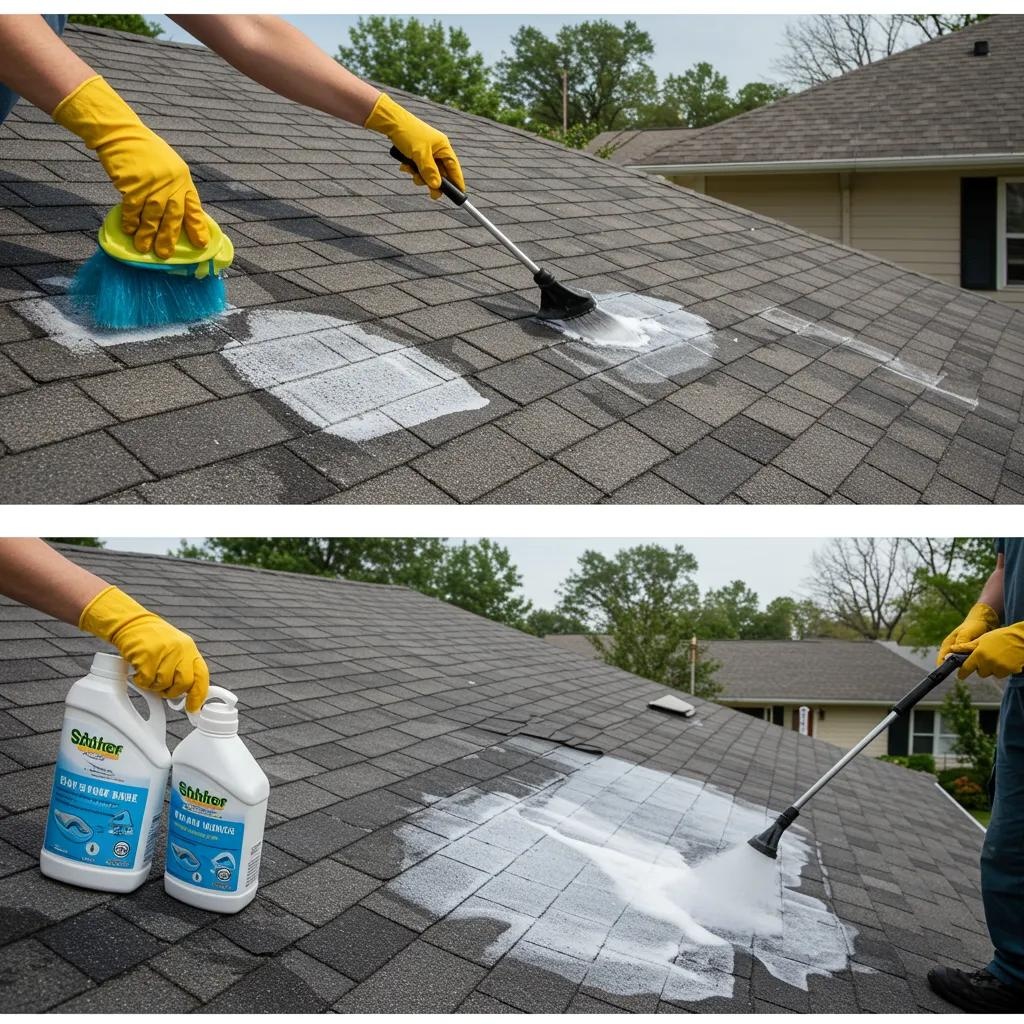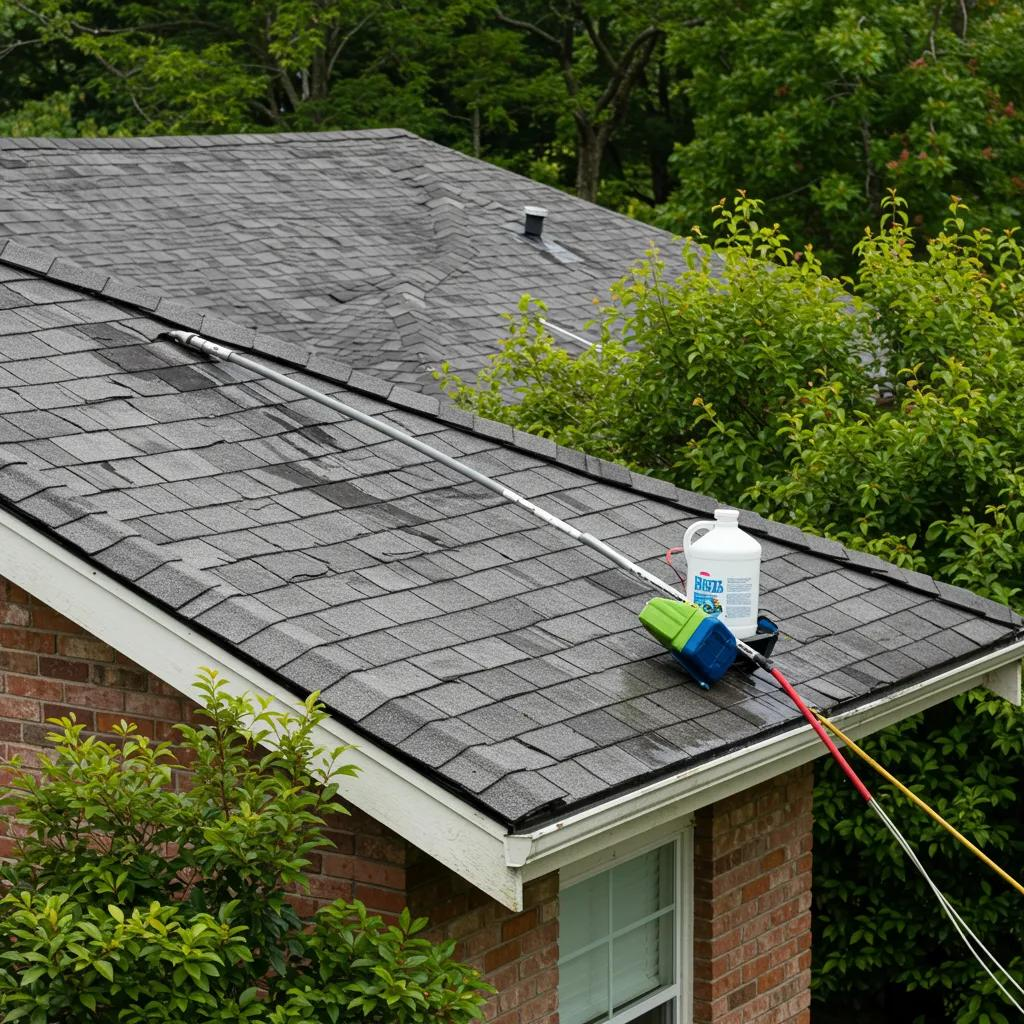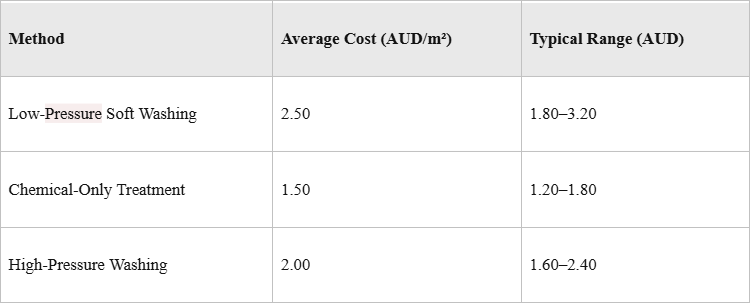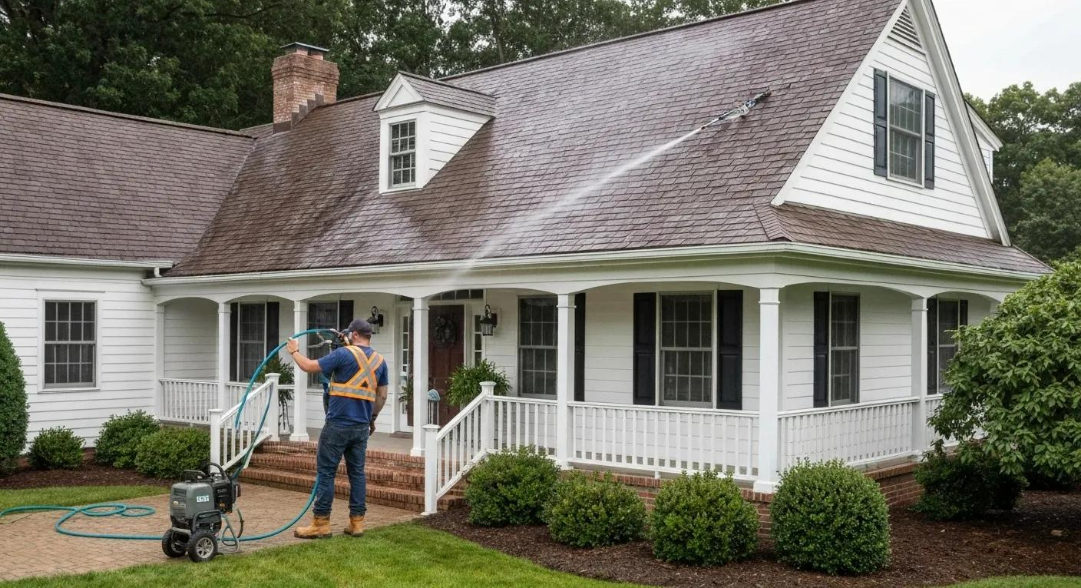Did you know that up to 85% of early roof deterioration is caused by unchecked moss, algae, and lichen growth? Low-pressure roof cleaning (also called soft washing), offers Adelaide homeowners a gentle yet powerful solution to eliminate organic contaminants, preserve warranties, and boost curb appeal. In this guide, you’ll discover what soft washing is, how it works, its advantages and drawbacks, comparisons with high-pressure washing, roof-type applications, why Adelaide Roofing and Construction leads the field, and answers to common homeowner questions.
The Impact of Algae and Moss on Roof Deterioration
Organic growths like moss and algae can significantly contribute to roof deterioration. Moss retains moisture, leading to softened and decayed shingles, while algae (Gloeocapsa magma) feeds on limestone fillers in asphalt shingles, weakening the granule layer and accelerating aging.
What Is Low-Pressure Roof Cleaning and How Does Soft Washing Work?
Low-pressure roof cleaning is a method that uses water at pressures under 500 PSI combined with biodegradable detergents to remove organic growth without damaging shingles or tiles. By relying on chemical action rather than sheer force, soft washing protects fragile roofing materials and extends roof life. For example, a typical soft wash application on an asphalt roof eliminates algae stains in under 30 minutes without granule loss.
What Makes Low-Pressure Roof Cleaning Different from High-Pressure Washing?
Low-pressure soft washing uses 100–500 PSI and specialised surfactants, while high-pressure washing exceeds 1,500 PSI and relies on mechanical force.
- Gentle removal avoids shingle dislodgement, granule erosion, and cracked tiles.
- Reduced water intrusion prevents leaks under flashing and ridge capping.
- Chemical dwell time ensures root-level eradication of algae and moss.
Low-pressure cleaning protects roof integrity and manufacturer warranties that high-pressure methods often void.
Roof Cleaning Methods and Warranty Preservation
The Asphalt Roofing Manufacturers Association (ARMA) advises against using high-pressure washing systems on asphalt shingles, as they can dislodge protective granules and damage roofing materials. Such methods can also void manufacturer warranties. Instead, ARMA recommends using a diluted solution of liquid household bleach and water, applied gently, to lighten algae discoloration.
How Does the Soft Washing Process Safely Remove Roof Contaminants?

Soft washing combines targeted chemistry with a controlled rinse sequence:
- Technicians apply a low-biodegradability detergent to all roof surfaces.
- The solution dwells 10–15 minutes, penetrating and disabling spores.
- A low-pressure rinse at 300–500 PSI removes dead growth and residual detergents.
This three-step sequence ensures complete removal of moss, algae, and lichen without imposing stress on roof materials.
Which Chemicals Are Used in Soft Wash Roof Cleaning?
Before presenting the table, note that all solutions used by Adelaide Roofing and Construction are EPA-approved and locally compliant.

These ingredients work synergistically to eliminate contaminants while minimising environmental impact.
What Are the Key Benefits of Low-Pressure Roof Cleaning for Adelaide Homes?
Low-pressure roof cleaning delivers lasting protection, aesthetic improvement, and environmental safety by using mild water pressure and targeted detergents. Homeowners experience fewer repairs, enhanced roof longevity, and preserved manufacturer warranties.
How Does Low-Pressure Cleaning Prevent Roof Damage and Extend Lifespan?
By avoiding excessive water pressure, soft washing prevents:
- Granule loss in asphalt shingles.
- Micro-fractures in terracotta and slate tiles.
- Water infiltration behind gutters and flashings.
Preserving roofing material integrity translates directly into an extended service life and fewer unexpected repairs.
How Does Soft Washing Eradicate Algae, Moss, and Other Organic Growth?
Soft washing targets contaminants at their root:
- Biocides penetrate spore structures of Gloeocapsa magma and common moss.
- A dwell time of 10–15 minutes ensures complete cellular breakdown.
- Rinsing flushes away debris and inhibits regrowth for up to 12 months.
This approach delivers longer-lasting cleanliness compared to surface-only removal.
In What Ways Does Low-Pressure Cleaning Enhance Curb Appeal and Property Value?
A clean roof immediately refreshes a home’s exterior:
- Uniform coloration restores original roof tone.
- Absence of streaks and dark patches boosts perceived maintenance standards.
- Improved aesthetics contribute up to 5% increase in resale value.
Enhanced visual appeal also signals proactive upkeep to potential buyers.
Why Is Soft Washing Considered Eco-Friendly and Safe for the Environment?

Soft washing reduces water use by up to 50% compared to high-pressure rinses and employs biodegradable formulas that:
- Break down without harming plant life around downspouts.
- Meet South Australian runoff regulations for stormwater.
- Avoid harsh sodium hypochlorite concentrations above 5%.
Environmental Considerations for Roof Cleaning Chemicals
Common soft washing chemicals like sodium hypochlorite and surfactants are effective in removing organic growth. While some solutions are designed to be biodegradable, professionals must take precautions such as proper dilution, controlled application, and protecting surrounding vegetation to minimise runoff and potential harm to plants and aquatic life.
This method aligns with local environmental standards and community expectations.
How Does Low-Pressure Cleaning Preserve Roof Warranties?
Most roofing manufacturers stipulate a maximum wash pressure of 600 PSI. Soft washing at 300–500 PSI:
- Complies with asphalt shingle warranty requirements.
- Keeps clay and concrete tile warranties intact.
- Avoids voiding metal roof finish warranties by preventing coating abrasion.
Adopting manufacturer-recommended methods ensures continued warranty coverage.
Can Low-Pressure Roof Cleaning Improve Energy Efficiency?
By removing dark biofilm and organic debris, soft washing restores solar reflectivity:
- Cooler roof surfaces reduce attic temperatures by up to 10°C.
- Lower cooling loads can trim energy bills by 5–8%.
- Reflective properties of Colorbond and metal roofs are fully restored.
Improved thermal performance contributes to overall household efficiency.
What Are the Disadvantages and Considerations of Low-Pressure Roof Cleaning?
While soft washing offers many upsides, homeowners should weigh costs, limitations, and chemical handling practices.
How Does the Initial Cost of Low-Pressure Cleaning Compare to Other Methods?
Below is a cost comparison per square metre for common cleaning approaches.

Soft washing’s higher investment pays dividends through reduced repair costs and extended roof life.
Are There Limitations to What Low-Pressure Cleaning Can Remove?
Soft washing excels at organic control but may not fully eliminate:
- Deeply ingrained mineral stains (iron oxide streaks).
- Paint overspray or roofing tar.
- Hardened cementitious efflorescence.
Rarely, follow-up treatments or spot remediation may be necessary for non-organic residues.
What Environmental and Safety Concerns Exist Regarding Chemical Use?
Professional handling protocols mitigate potential risks:
- Technicians wear protective gear to avoid skin or eye exposure.
- Runoff is directed away from storm drains using biodegradable containment.
- Careful dilution prevents vegetation damage under gutter lines.
These precautions ensure homeowner, technician, and ecosystem safety.
How Does Low-Pressure Roof Cleaning Compare to High-Pressure Washing?
Low-pressure and high-pressure methods serve different purposes; choosing correctly hinges on surface tolerance and desired outcome.
Why Is High-Pressure Washing Risky for Roof Materials?
High-pressure jets can:
- Dislodge ceramic tile edges and strip shingle granules.
- Force water beneath flashings, causing interior leaks.
- Abrade metal roof coatings, leading to premature corrosion.
Such mechanical damage often necessitates costly repairs.
When Is High-Pressure Washing Appropriate Versus Low-Pressure Cleaning?
High-pressure washing is best reserved for:
- Concrete driveways and masonry walls.
- Industrial steel structures rated for >2,000 PSI.
- Situations where chemical use is restricted or prohibited.
For any roofing surface, soft washing remains the safest choice.
How Does Low-Pressure Roof Cleaning Work on Different Adelaide Roof Types?
Local roof styles demand tailored soft wash applications to ensure optimal results.
Is Soft Washing Safe and Effective for Asphalt Shingles?
Soft washing at 300–500 PSI and gentle surfactants:
- Maintains shingle granules and UV protective coating.
- Eliminates black streaks caused by Gloeocapsa magma.
- Complies with Asphalt Roofing Manufacturers Association guidelines.
This method revitalises shingle appearance without surface abrasion.
How Does Low-Pressure Cleaning Protect Terracotta and Clay Tile Roofs?
Soft washing preserves the porous structure of clay tiles by:
- Using low-pH detergents that prevent surface etching.
- Avoiding high-speed water streams that cause tile cracking.
- Applying sealant post-clean to enhance water repellency.
Terracotta roofs regain their rich hues and protective function.
What Are the Advantages of Soft Washing Colorbond and Metal Roofs?
For Colorbond steel and metal roofing, low-pressure cleaning:
- Restores factory finishes without disturbing paint coatings.
- Prevents galvanic corrosion by avoiding harsh abrasives.
- Enhances solar reflectance, improving thermal performance.
Metal roofs achieve a showroom finish without risk.
Why Choose Adelaide Roofing and Construction for Your Low-Pressure Roof Cleaning Needs?
Partnering with a certified local specialist delivers peace of mind and top-tier results.
What Expertise and Safety Standards Does Adelaide Roofing and Construction Follow?
Our technicians hold industry certifications in fall arrest systems, WHS protocols, and chemical handling. We:
- Perform pre-service roof inspections to tailor detergent formulas.
- Adhere to Safety Data Sheet guidelines for all cleaning agents.
- Maintain full public liability and professional indemnity insurance.
Safety and quality drive every project.
How Does Our Local Adelaide Focus Benefit Customers?
A local Adelaide business offers:
- Rapid response times and same-day or next-day scheduling.
- Knowledge of regional weather patterns that influence cleaning frequency.
- Familiarity with South Australian environmental regulations.
Community-based service ensures personalised attention.
What Do Our Customers Say?
- “Our terracotta roof looked brand new! no streaks, no damage and zero fuss.”
- “The team was punctual, professional and left our gutters clear. Highly recommend.”
These testimonials reflect consistent satisfaction and trust in our low-pressure approach.
What Are the Most Frequently Asked Questions About Low-Pressure Roof Cleaning?
Homeowners often wonder about safety, cost, and effectiveness. The following questions highlight common concerns and expert clarifications.
Is Soft Washing Safer Than Pressure Washing for Roof Tiles?
Soft washing is safer because it combines low water pressure with specialised detergents to remove biological growth without dislodging or cracking fragile roof tiles.
How Much Does Low-Pressure Roof Cleaning Cost in Adelaide?
Typical soft wash projects in Adelaide range from AUD 0.30 to 0.75 per square foot, influenced by roof size, slope, and complexity of organic buildup.
Can Low-Pressure Cleaning Damage My Roof?
When performed by trained professionals at the correct PSI, soft washing prevents roof damage rather than causing it, avoiding issues like granule loss or flashings infiltration.
What Chemicals Are Used in Soft Wash Roof Cleaning?
The formulas include sodium hypochlorite, sodium hydroxide, and non-ionic surfactants, all in concentrations approved for rapid biodegradation and minimal environmental impact.
Low-pressure roof cleaning provides Adelaide homeowners with a reliable, warranty-safe method to maintain roofing health and enhance property value. By choosing soft washing over high-pressure alternatives, you protect your investment, reduce future repair costs, and contribute to a greener, more energy-efficient home. Contact Adelaide Roofing and Construction today to schedule your gentle, thorough roof restoration.

